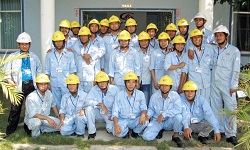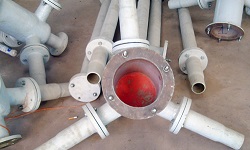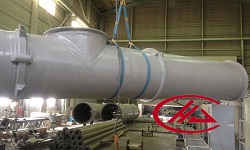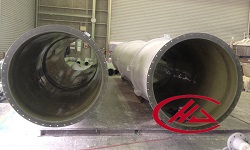Machine Made Piping
In the 1950s centrifugal casting was the first machine made method to produce pipe suitable for chemical and commercial applications and oil field gathering lines. Next a filament winding process was developed to manufacture pipe with tensioned glass fibers oriented to bear
the combination of hoop and axial forces. Filament winding with a dual angle construction called for layers of glass fibers in a near axial orientation and resulted in developing high pressure (up to 2,000 psi) down hole tubing for producing wells. Some of these earlier FRP tubing strings remain in service after more than 35 years of production. In the 1960s an efficient high volume continuous pipe production process was developed for small diameter pipe rated for pressures (up to 450 psi). Large scale use of this pipe began in 1964 and was primarily installed in two inch crude oil gathering lines.
Codes and Standards Development
In 1959 the first nationally recognized standards and test methods for FRP pipe were published by the American Society for Testing Materials ("ASTM"). This first specification was ASTM D1694, Standard Specification for Threads for Glass Fiber Reinforced Thermosetting Resin Pipe and developed by a group composed of representatives from fiberglass pipe manufacturers, oil companies and other industries.
In 1968 the American Petroleum Institute ("API") published their first FRP pipe standard. This first API standard was API 15LR, Specification for Glass Fiber Reinforced Thermosetting Resin Line Pipe. Today ASTM and API publish numerous standards, specifications and test methods for FRP piping.
Today
Today the use of FRP machine made piping has grown from its original major use in oil field gathering lines to applications ranging from handling flammable and combustible liquids at retail consumer facilities to sewer and water mains in the municipal and industrial markets. Following are examples of current FRP piping applications:
In the oil and gas production industry, high pressure applications include 4,000 psi
4 inch pipe in oil field service, 2 to 16 inch pipes for water filtration projects in climatic conditions as cold as Alaska and as hot as the Persian Gulf, and a salt water/crude oil 12 inch pipeline operating at 290 psi at temperatures up to 120o F
Flammable and combustible liquid handling includes the underground piping of gasolines, gasoline-alcohol mixtures and alcohols at most of the nations retail and commercial vehicle refueling facilities. Since FRP piping was Underwriters Laboratory Listed in the late 1960s, over 60 million feet have been successfully installed and serve the nation motoring public.
While sewer and drainage piping continues to be dominated by concrete, there are many areas where FRP is the preferred choice. For example, concrete pipe deteriorates rapidly in sewage due to hydrogen sulfide attack. Hydrogen sulfide erodes the upper surface of the pipe and will eventually cause a cave-in. FRP is unaffected by hydrogen sulfide or purging with caustic or hypochlorite to suppress sulfide odor. As a result, FRP pipe has been used as a liner in large diameter (48 to 60 inches) concrete pipe.
The Future
Architectural and engineering firms are now able to use computer software programs developed to enhance the design of FRP piping systems. The program includes liquid flow analysis, gas flow analysis, free span analysis, thrust block design, chemical composition and installation information. The program makes it easy to step through complicated calculations and analysis when designing a new FRP piping system or for troubleshooting an existing FRP piping system.
The oil and gas production industry will be requiring higher pressure rated and larger diameter piping to control corrosion problems in produced fluid lines (It is not uncommon to "produce" and treat seven barrels of water for each barrel of crude oil brought out of the ground). In addition to solving corrosion problems, FRP piping can be designed with a flame retardant additive to reduce flame spread for non-critical areas or in critical areas, be coated with an intumescent paint or insulated with an intumescent material i. e., the paint and coating expands to form an incombustible foam insulation. This latter system will maintain the serviceability of the piping for a minimum of three hours under flow conditions. FRP firewater protection piping is solving weight problems when designing offshore oil production platforms. Weight savings in the design of a platform can save the owner from $2.00 to $4.00 per pound in construction costs by reducing the weight of the support structure (e.g., savings up to 750 tons).
Trench-less Piping is a rapidly growing technology where micro-tunneling for new piping and slip-lining for rehabilitating existing piping do not disturb roadbeds or other aboveground structures.








